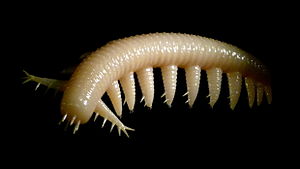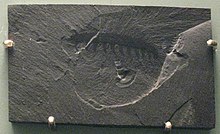Aysheaia
| Aysheaia | ||||||||||||
|---|---|---|---|---|---|---|---|---|---|---|---|---|

Reconstruction of Aysheaia |
||||||||||||
| Temporal occurrence | ||||||||||||
| Middle Cambrian | ||||||||||||
| 507 to 505 million years | ||||||||||||
| Locations | ||||||||||||
|
||||||||||||
| Systematics | ||||||||||||
|
||||||||||||
| Scientific name | ||||||||||||
| Aysheaia | ||||||||||||
| Walcott , 1911 | ||||||||||||
| Art | ||||||||||||
|
Aysheaia is a genus of extinct molting animals from the group of lobopodia , one of a kind from the middle with each Cambrian of Burgess Shale in Canada and Wheeler formation in the State of Utah is known. Similar forms have been found in the Chengjiang faunal community of Maotianshan slate in western China's Yunnan Province,which is about 10 million years older.
The name Aysheaia is derived from the mountain "Ayesha" north of Mount Wapta .
anatomy
The 1-6 cm long organism had an elongated worm-shaped body consisting of at least 12 body segments, which were laterally joined by ten pairs of conical, stubby legs provided with small claws. Aysheaia also had a fine, superficial ring that did not match the body segmentation.
The mouth opening facing forward was lined with six finger-like protuberances (papillae), which helped the animal to eat. Aysheaia had in addition to the 10 leg processes a pair of spiky antennae in the front part of the trunk, which was not separated from the rest of the body as a head. Presumably the front appendages also supported the animal in grasping and eating the prey.
ecology
Due to the fact that many specimens were found together with the fossil remains of sponges ( sclerites ), it can be assumed that Aysheaia lived on them and fed on them. Aysheaia probably used the claws on the appendages of the legs to cling to the sponges. It is believed that the unarmored animal also sought protection from predators in the sponge colonies .
19 specimens of A. pedunculata are known from the Burgess slate in Canada. This makes A. pedunculata one of the rarer fossils of the Burgess schist. A. prolata is known to an individual from the Wheeler formation.
Systematics
Aysheaia shows striking similarities with recent representatives of the columbus (Onychophora) and the tardigrade (Tardigrada) and is therefore regarded by some as their forerunners, but not classified in any of these groups. Instead, Aysheaia is counted among the Cambrian representatives of the lobopods.
literature
- RA Robison: Affinities of Aysheaia (Onychophora), with Description of a New Cambrian Species, in: Journal of Paleontology , Vol. 59, No. 1 (Jan. 1985), pp. 226-235.
Web links
Individual evidence
- ^ BCGNIS Geographical Name Details . Archived from the original on July 6, 2011. Info: The archive link was automatically inserted and has not yet been checked. Please check the original and archive link according to the instructions and then remove this notice. Retrieved May 6, 2011.
- ↑ a b H. B. Whittington: The Lobopod Animal Aysheaia pedunculata Walcott, Middle Cambrian, Burgess Shale, British Columbia, in: Philosophical Transactions of the Royal Society of London. Series B, Biological Sciences , Vol. 284, No. 1000 (Nov. 16, 1978), pp. 165-197.
- ↑ Aysheaia pedunculata (a velvet worm) . Smithsonian National Museum of Natural History. Retrieved May 7, 2011.

